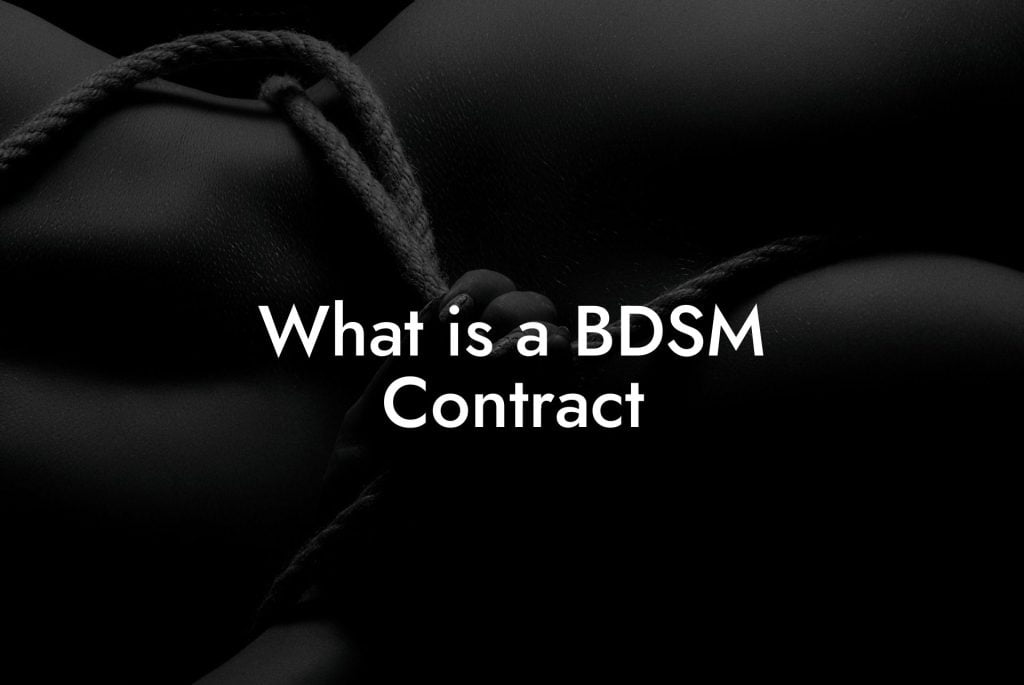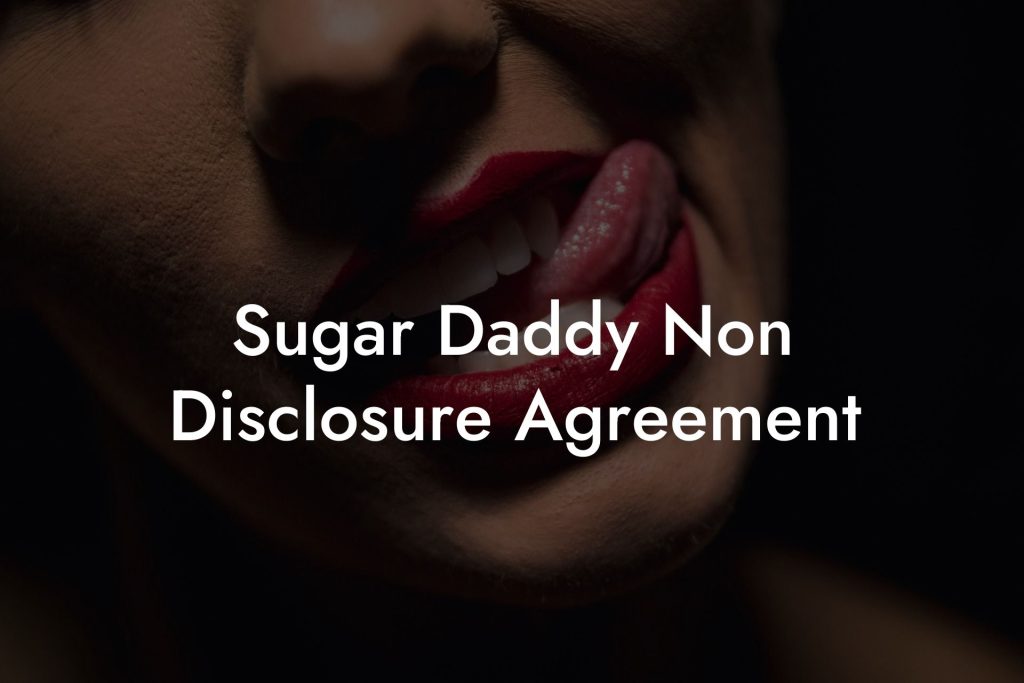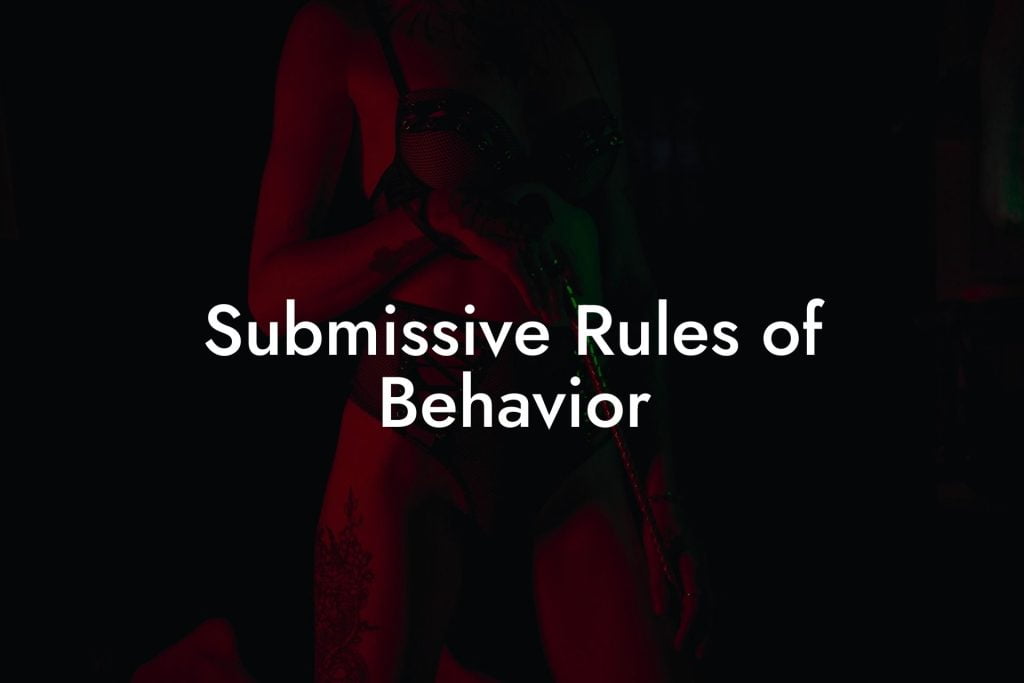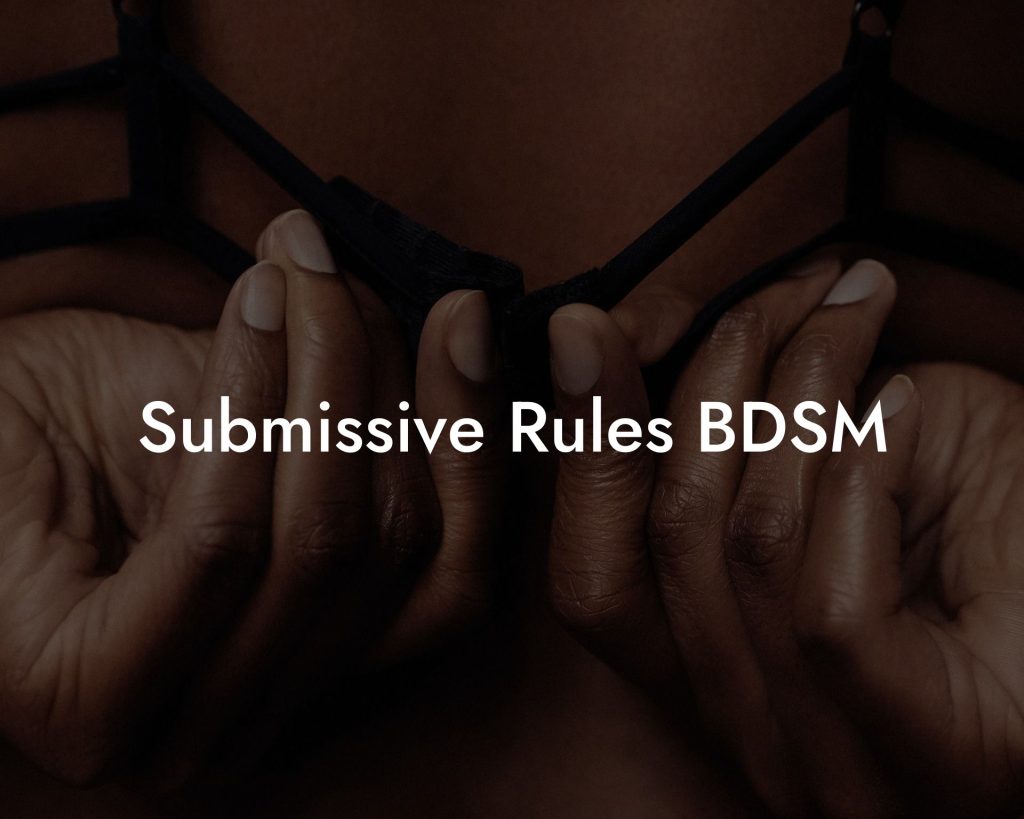Submissives play a crucial role in the BDSM world, bringing passion, surrender, and trust to their dominant partners. Whether you're a curious newbie or an experienced submissive looking to refine your skills, this article is here to guide you through the rules and principles that define submissive behavior. From communication and consent to understanding your own limits and desires, let's delve into the captivating world of submissives.
In any BDSM relationship, consent is the cornerstone of trust and respect. It’s more than just saying “yes” or “no”—it’s about openly communicating your desires, limits, and expectations. But trust doesn’t end with a conversation—it’s built through ongoing, clear agreements. That’s where our Dominant & Submissive BDSM Contract Pack comes in. Find out more →
Understanding Submissive Behavior
Being a submissive is more than just following orders; it's a mindset and an expression of trust. It involves finding pleasure in relinquishing control and serving your dominant partner. Submissive behavior varies from person to person, but some common aspects include obedience, respect, and an eagerness to please.
Consent and Communication
Consent is the cornerstone of any BDSM relationship. Submissives must have the power to set boundaries and communicate their limits effectively. Establishing a safe word or non-verbal signal is crucial for maintaining open communication and ensuring the well-being of everyone involved. Trust is built upon transparent and ongoing conversations, allowing both parties to explore their desires while unwaveringly respecting each other's boundaries.
Establishing Rules and Rituals
Rules and rituals provide structure and guidance within a BDSM dynamic. They can range from simple tasks like kneeling or maintaining a specific posture to more complex responsibilities. Submissives must understand and willingly comply with the set rules, as they serve as a foundation for trust, discipline, and personal growth. Negotiation and consent play a vital role in defining these rules to align with each individual's preferences and comfort levels.
Understanding Limits and Safewords
Everyone has limits, and submissives must have a deep understanding of their personal boundaries. Consensual exploration is essential, but it should always be within the individual's comfort zone. Establishing safewords ensures that both the dominant and submissive can immediately halt or adjust any activity if it becomes overwhelming or crosses a preset limit. Safewords should be easy to remember and distinguish from normal conversation, effectively signaling the need for immediate attention.
Looking for the best BDSM & Kink OnlyFans content creators? Here is a list of of our favourites that you will love:
-
- Best BDSM & Fetish OnlyFans - Molly✨ >> Link
- Best BBW & Huge Ass OnlyFans - Naughty Hanna Zimmer 💜🎀 >> Link
- Best Sexy Gaming Nerd OnlyFans - 🎮 Gracy EstuSWEET 🎮 >> Link
- Best Fetish & Kink Messaging OnlyFans - 💫Lola La Fleur 💫 >> Link
- Best Girl Next Door OnlyFans - ☀️Lily ⛅ >> Link
- Best Tiny European OnlyFans - 💝 Ami Allison 💝 >> Link
- Best Cosplay OnlyFans - 🐱 Little Kitty Kate 👉👌 >> Link
- Best Little OnlyFans - 🧸 Katya 🙇♀️ Sun >> Link
- Best Sub OnlyFans - 🍌Hanna Banana🍌 >> Link
- Best Teen & Huge Tits OnlyFans - ❣️Anny❣️19 y.o. BUSTY student girl >> Link
- Best Tiny Tits OnlyFans - ⍣⭐️ Sofia Parker ⭐️⍣ >> Link
- Best Sub & Huge Boobs OnlyFans - Nika Huge Boobs >> Link
- Best Kink OnlyFans - Sofia💖 >> Link
- Best Fetish & Girl Next Door OnlyFans - Hillary is Wet 💦 >> Link
- Best Dirty Latina OnlyFans - Paula Flores 😈 >> Link
Not quite what you are looking for? View the full list →
Frequently Asked Questions
What is a BDSM Contract?
A BDSM contract is a written agreement between participants in BDSM activities that outlines the expectations, boundaries, rules, and responsibilities of each party. It is a tool used to ensure clear communication and consent, and it serves as a reference point for the relationship or scene. Contracts can range from simple verbal agreements to detailed written forms.
Why are BDSM Contracts important?
BDSM contracts are important for establishing trust and understanding between participants. They help to clarify what is expected of each person and set boundaries that protect the safety and well-being of everyone involved. It's a way to formalize consent and to make power dynamics clear and consensual.
How detailed should a BDSM Contract be?
The level of detail in a BDSM contract depends on the needs and preferences of those involved. Some may prefer a high level of detail to leave no room for misunderstanding, while others may opt for a more general agreement with flexibility. It's important that all parties feel their needs and limits are adequately represented.
What are BDSM power dynamics?
BDSM power dynamics refer to the negotiated roles and power structures within a BDSM relationship or scene. This can include dominance and submission, master/slave, owner/property, etc. These relationships can vary greatly in terms of intensity and permanence.
How does consent play a role in BDSM?
Consent is the cornerstone of all BDSM activities. It ensures that all parties are aware of and agree to the risks, activities, and conditions involved. Consent must be informed, voluntary, and revocable at any time, and it is what differentiates BDSM from abuse.
What are some safety measures to consider in BDSM?
Safety measures in BDSM include agreeing on a safe word or gesture, discussing hard and soft limits beforehand, being aware of possible physical and emotional risks, engaging in aftercare, and learning about proper techniques and first aid. It's important to keep communication open and to regularly check in with your partner.
Is a BDSM Contract legally binding?
In most places, a BDSM contract is not legally binding. They are more symbolic agreements that outline the expectations and responsibilities of each party rather than a legal document. However, they do represent a personal commitment and understanding between the participants.
How do you negotiate a BDSM Contract?
Negotiating a BDSM contract involves open and honest communication where all parties discuss their desires, limits, rules, and any other relevant details. It’s important to be clear about expectations and to listen to one another actively, without judgement. Consideration of physical and emotional limits is crucial.
What are hard limits in BDSM?
Hard limits in BDSM are the activities or scenarios that an individual is not willing to engage in, under any circumstance. These are non-negotiable and must be respected by all parties involved. Lists of hard limits should be clearly outlined in the BDSM contract to prevent any unwanted activities.
Can a BDSM Contract change over time?
Yes, a BDSM contract can and should be revisited and revised as the relationship or dynamics evolve. Changes in limits, interests, or the relationship itself may necessitate updates to the contract, always with the informed consent of all parties.
Is aftercare part of BDSM Contracts?
While it might not be explicitly stated in every contract, aftercare is an essential aspect of BDSM and can be included. Aftercare involves attending to the physical and emotional needs of participants after a scene to ensure well-being and to support reconnection and recovery.
What should you do if boundaries are crossed?
If boundaries are crossed, it's important to stop the scene immediately using the agreed-upon safe word or gesture. Afterwards, communicate openly about what happened, how it affected each person, and what steps can be taken to prevent it from occurring again. Professional help or support may be necessary if any trauma has been experienced.
How often should you review your BDSM Contract?
BDSM contracts should be reviewed regularly, especially if there are changes in the relationship dynamics or personal limits. It's advisable to set a schedule for review upon signing the contract, such as every few months or once a year, to ensure it remains relevant and consensual.
Can someone withdraw consent during a BDSM scene?
Consent can and should be able to be withdrawn at any moment within a BDSM scene. Safety and comfort are paramount, and all participants should respect the use of safe words or gestures that indicate the withdrawal of consent. Continuing any activity after consent is withdrawn is considered abuse.
Do all BDSM interactions require a contract?
Not all BDSM interactions require a contract, especially for more casual or spontaneous activities. However, they are strongly recommended for ongoing relationships or complex scenes where the power dynamics and activities are intricate or carry more risk.
How should a beginner approach BDSM contracts?
Beginners should approach BDSM contracts with an open mind and a willingness to learn. It's important to do thorough research or to seek guidance from experienced community members. Starting with a simple agreement that covers basics like safe words and basic limits can be a good starting point.
Are BDSM Contracts confidential?
BDSM contracts are private agreements between consenting adults and should be treated with confidentiality. Unless all parties agree to share the contents with others, the contract should be kept between those directly involved.
What is a safe word?
A safe word is a pre-agreed upon word or phrase that participants in a BDSM scene can use to stop the activity immediately. It's a clear signal that something is wrong, whether it's due to discomfort, a limit being approached, or any other reason. Safe words are an essential tool for maintaining consent and safety.
How can trust be established in a BDSM relationship?
Trust in a BDSM relationship is established through consistent, open, and honest communication, respecting boundaries and agreements, and by demonstrating reliability and care over time. It involves a willingness to be vulnerable and to prioritize the well-being of all participants.
What is edgeplay, and should it be included in a BDSM contract?
Edgeplay refers to BDSM activities that are considered more risky or extreme. Because these activities often carry higher physical or psychological risk, they should be approached with great caution and should absolutely be included in a BDSM contract if they are to be part of the relationship or scene.
What is the difference between a scene and a relationship in BDSM?
A scene refers to a specific instance or occasion of BDSM activity, which may be a one-time event or part of an ongoing arrangement. A relationship in BDSM context usually denotes a more enduring connection that encompasses not just scenes but a wider range of interactions and dynamics.
Remember, the journey of submission is unique to each individual. Explore our comprehensive guides on Filthy Adult to dive deeper into the world of BDSM. If you're ready to establish clear boundaries and embrace the power dynamics, consider ordering our Ultimate BDSM Contract Pack. And don't forget to visit our fetish shop, where you can find an exquisite collection of items to fulfill all your kinkiest desires. Share this article with fellow enthusiasts and continue exploring the captivating realm of submission.













